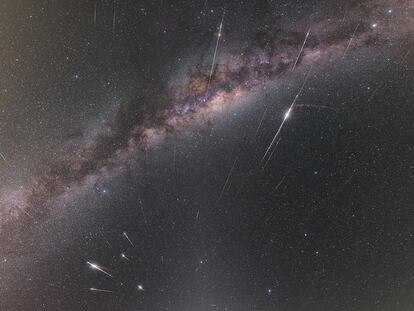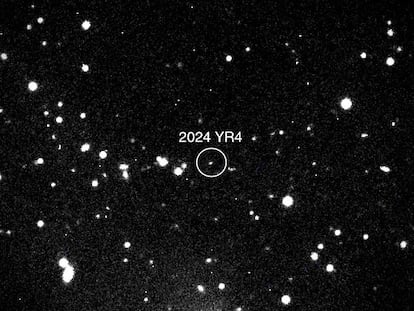Eta Aquarid meteor shower: When and where to catch its peak in the US
Observers will not need telescopes or binoculars to enjoy this phenomenon


One of the most dazzling skywatching events of the year is approaching. The Eta Aquarid meteor shower — an annual spectacle caused by the remnants of Halley’s comet — is expected to peak before dawn on May 6, with increased activity in the early morning hours of May 5-6.
For Southern Hemisphere observers, this is the best meteor shower of the year. Those in the Northern Hemisphere will not see as many shooting stars, but if they are patient in dark skies they may be rewarded with some bright flashes, and even a rare “fireball” (better known as an Earthgrazer).
When and where to watch the Eta Aquariids
The Eta Aquariids are visible for several weeks, usually from April 15 through May 27, but the key dates for viewing are May 5 and 6. The best time to observe them is before dawn on both days, which is when the radiant — the point in the sky where the meteors appear to originate — is at its highest point.
The radiant of the shower is located near the Water Canary, in the constellation Aquarius, which reaches its highest point just before sunrise. This means that the closer it is to the equator or in the Southern Hemisphere, the more meteors can be seen.
How many meteors can be expected?
Under ideal conditions (dark skies, no moonlight and the radiant overhead) up to 60 meteors per hour could be seen. In the United States, which is north of the equator, only 10 to 20 meteors per hour will be seen at best.
This year’s moon phase is relatively favorable. The Moon will reach its first quarter on May 4 and, by the climax, will be in its crescent phase —at 64% illumination— but will set around 03.00 am, just in time to allow a dark, moonless sky for early morning viewing.
What is the origin of the Eta Aquariids?
The origin of the Eta Aquariids meteor shower is the famous Halley’s comet. When Halley passes through the inner solar system every 76 years, it releases dusty particles, a trail of debris that the Earth passes through twice a year. In May, our planet encounters the debris left by the comet for the first time, giving rise to the Eta Aquariids. In October, the Earth’s orbit again coincides with Halley’s debris, giving rise to the Orionids meteor shower. Halley’s comet last passed close to Earth in 1986 and will return in 2061.
Meteoroids from Halley’s comet enter Earth’s atmosphere at breakneck speed — about 41 miles per second (66 kilometers per second) — and burn up at an altitude of about 62 miles (100 kilometers), producing the bright fireballs we see as meteors. Some may leave trails that remain visible in the night sky for several seconds or more.
Tips for observing
Observers do not need telescopes or binoculars; in fact, your eyes are the best tool for observing meteors. It is recommended to be in a dark place away from city lights (such as a national park), let your vision adjust for about 20 minutes, and find a comfortable position under a wide, open sky.
Meteors can streak across any point in the sky, even if they appear to radiate from Aquarius. Star showers are unpredictable: several meteors may appear within a few minutes, or they may take a long time to appear. But even a single bright meteor — especially an Earthgrazer, which streaks horizontally across the sky — will make it worth waking up early.
Sign up for our weekly newsletter to get more English-language news coverage from EL PAÍS USA Edition
Tu suscripción se está usando en otro dispositivo
¿Quieres añadir otro usuario a tu suscripción?
Si continúas leyendo en este dispositivo, no se podrá leer en el otro.
FlechaTu suscripción se está usando en otro dispositivo y solo puedes acceder a EL PAÍS desde un dispositivo a la vez.
Si quieres compartir tu cuenta, cambia tu suscripción a la modalidad Premium, así podrás añadir otro usuario. Cada uno accederá con su propia cuenta de email, lo que os permitirá personalizar vuestra experiencia en EL PAÍS.
¿Tienes una suscripción de empresa? Accede aquí para contratar más cuentas.
En el caso de no saber quién está usando tu cuenta, te recomendamos cambiar tu contraseña aquí.
Si decides continuar compartiendo tu cuenta, este mensaje se mostrará en tu dispositivo y en el de la otra persona que está usando tu cuenta de forma indefinida, afectando a tu experiencia de lectura. Puedes consultar aquí los términos y condiciones de la suscripción digital.
More information
Archived In
Últimas noticias
NASA discovers Titan doesn’t have an ocean, but a ‘slushy ice layer’ that increases possibility of life
Innocence lost in the forest of the child soldiers: ‘Each leader of the armed group had his girls’
‘Fallout’ or how the world’s largest company turned an anti-capitalist apocalyptic Western into a phenomenon
From inflation to defending migrants: Eileen Higgins and Zohran Mamdani inaugurate the new Democratic resistance against Trump
Most viewed
- ‘El Limones’ and the growing union disguise of Mexican organized crime
- Christian Louboutin: ‘Young people don’t want to be like their parents. And if their parents wear sneakers, they’re going to look for something else’
- The low-cost creative revolution: How technology is making art accessible to everyone
- ‘We are dying’: Cuba sinks into a health crisis amid medicine shortages and misdiagnosis
- A mountaineer, accused of manslaughter for the death of his partner during a climb: He silenced his phone and refused a helicopter rescue










































